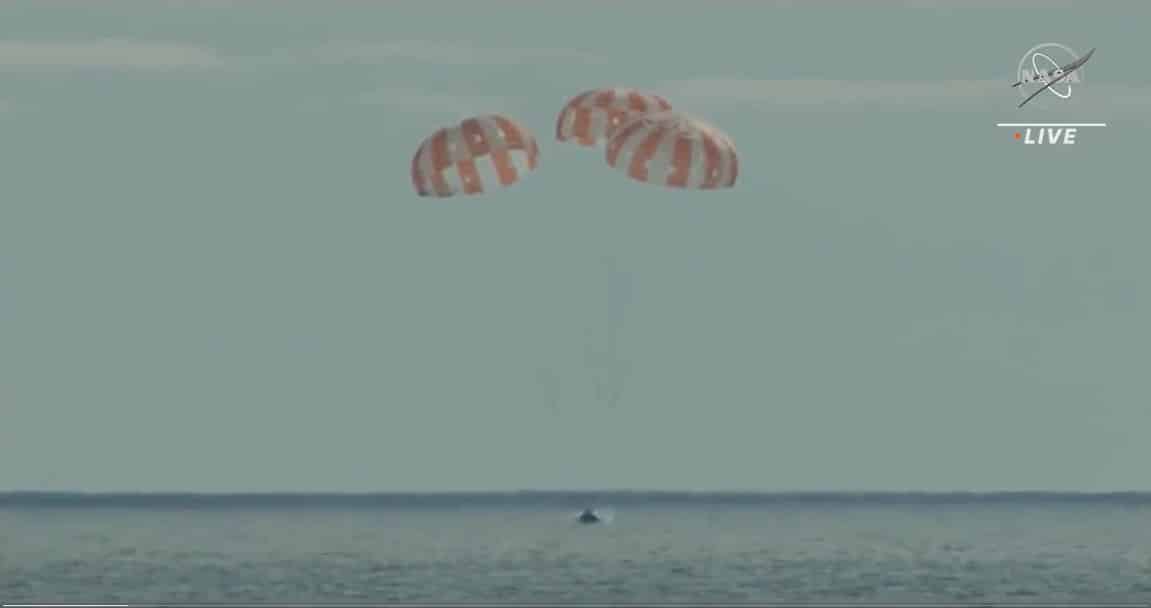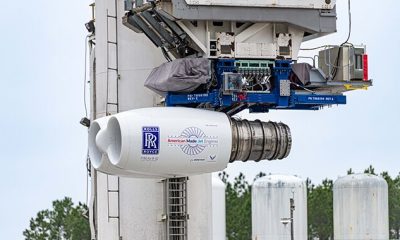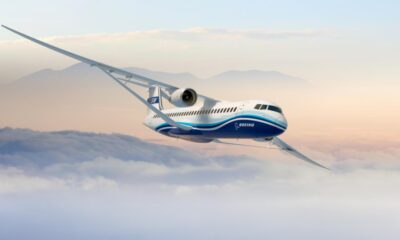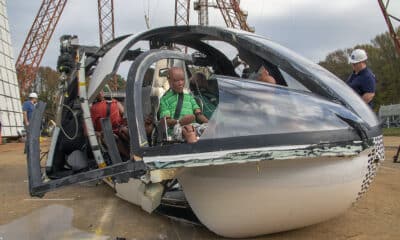Aerospace
NASA’s Artemis I Mission Sees Successful Completion

The splashdown and recovery of the Orion spacecraft marked the successful completion of NASA‘s Artemis I mission. This mission served as an unmanned, integrated flight test for the equipment and systems that will send people back to the Moon for the first time in more than 50 years.
The Space Launch System (SLS) rocket, Orion spacecraft and Exploration Ground Systems (EGS) at NASA’s Kennedy Space Center in Florida performed flawlessly during the Artemis I launch on Nov. 16. During a nearly 26-day mission, Orion traveled more than 1.4 million miles on a path that took it around and beyond the Moon before returning to Earth. The flight testing and data from the mission inform future Artemis missions.
As the foundational elements of NASA’s deep space exploration architecture, Orion is the safest human spacecraft ever developed, and the launch and ground systems were designed to deliver greater mass and volume with more Earth-orbit departure energy than any existing system. With planned upgrades, the architectures will be able to support future missions to destinations beyond the Moon, including Mars.
The next step in NASA’s Artemis program is launching the first crewed flight to the Moon and back on the Artemis II mission. All elements for that mission are deep into assembly. Work on Artemis III, which aims to put the first woman and person of color on the Moon, is well under way with many of the systems, such as the propulsion for SLS and Orion, nearly complete.
The Artemis program constitutes an important national capability that leverages more than 3,800 suppliers and 60,000 workers across all 50 states. The program sustains an essential industrial base of large, mid-size and small companies that provide high-tech, professional jobs across the country.
Meet the world’s first Space Tourists to fly around the Moon(Opens in a new browser tab)
Industry partners – Aerojet Rocketdyne, Boeing, Jacobs, Lockheed Martin and Northrop Grumman – applaud NASA and their suppliers across the nation for the successful once-in-a-generation accomplishment of launching SLS and Orion as humanity looks toward exploring deep space as humans never have before.
- Aerojet Rocketdyne provided the 39 propulsive elements to the mission, including the RS-25 and RL10 engines affixed to the core and upper stage that carried the SLS and Orion into orbit, as well as the jettison motor for the Orion spacecraft’s Launch Abort System (LAS).
- Boeing is the prime contractor for the design, development, test and production of the launch vehicle core stage and upper stages as well as the development of the flight avionics suite.
- Jacobs was responsible for the rocket’s final assembly, integration, testing, launch and recovery operations support, including development of the Artemis ground and launch control software used in the NASA Launch Control Center at Kennedy Space Center.
- Lockheed Martin is the prime contractor for the Orion spacecraft, including the LAS, crew module and crew module adaptor.
- Northrop Grumman contributed the twin solid rocket boosters that supplied more than 75% of the thrust at launch, as well as the abort motor and attitude control motor for the LAS.

Aerospace
Indigo will soon launch Air Taxi Service in India

InterGlobe Enterprises, the parent brand of IndiGo, is set to revolutionize travel in India with its upcoming air taxi service.
Scheduled for a potential launch in 2026, this innovative venture promises a seamless journey for passengers between two bustling hubs. Delhi and Gurgaon in Haryana. The forthcoming service is projected to revolutionize the daily commute, offering passengers a swift aerial journey covering the distance in a mere 7 minutes.
This remarkable efficiency contrasts starkly with the conventional 90-minute drive, underscoring the immense time-saving potential for commuters. The anticipated fare, ranging from Rs 2,000-3,000, makes this innovative mode of transport not only swift but also remarkably competitive in pricing.
At the heart of this ambitious endeavor lies a strategic partnership with Archer Aviation, a pioneer in electric vertical takeoff and landing (eVTOL) aircraft technology. Under this collaboration, Archer will supply 200 state-of-the-art eVTOL aircraft, representing an investment of US$ 1 billion. These cutting-edge aircraft, capable of accommodating up to four passengers alongside the pilot, epitomize the future of sustainable air travel.
Powered by six battery packs, Archer’s eVTOL aircraft boast rapid charging capabilities, enabling a swift turnaround between flights. With a charging time of just 30-40 minutes, these eco-friendly aircraft ensure minimal downtime, maximizing operational efficiency.
Similar services are anticipated to be introduced by the joint venture in Bengaluru and Mumbai as well. Nevertheless, the service rollout period has not yet been made public by the company. Next year, it is anticipated to get its certification. Following this, the company will start the certification procedure with the Directorate General of Civil Aviation (DGCA).
Aerospace
Which is bigger 777x or 787 aircraft ?

The 777X is a new series of the Boeing 777 family and is designed to be larger and more efficient than its predecessor. It features two variants: the 777-8 and the 777-9, being the larger of the two.
The Boeing 777X emerges as the larger sibling within the Boeing family, representing a significant leap forward in both size and efficiency. Comprising two variants, the 777-8 and the 777-9, the latter takes the crown as the larger of the two. With its expansive fuselage and impressive wingspan, the 777X is tailored for long-range journeys and boasts a substantial passenger capacity.
On the other hand, the Boeing 787, affectionately known as the Dreamliner, occupies a niche in the market as a smaller yet formidable aircraft designed for medium to long-range flights. Its distinguishing feature lies in its composite fuselage, a technological marvel that renders it lighter and more fuel-efficient compared to conventional aluminum counterparts. The Boeing 777X is larger than the Boeing 787 aircraft.
When it comes to passenger capacity, the 777-9 reigns supreme, typically accommodating a sizeable contingent of 400-425 passengers in its standard configuration. In contrast, the 787, with its more modest dimensions, typically carries between 240-290 passengers, depending on the variant and layout.
One of the remarkable innovations introduced with the 777X is its folding wingtips, a feature designed to address the logistical challenges of accommodating such a large aircraft in conventional airport gates. These folding wingtips enable the 777X to retract its wings, allowing it to fit into gates designed for smaller aircraft while still reaping the benefits of an extended wingspan during flight, thereby enhancing fuel efficiency and operational flexibility
Aerospace
China Secures Production Certificate for Mass Production of Pilotless eVTOL Aircraft

The first passenger-carrying pilotless electric vertical takeoff and landing (eVTOL) aircraft in the world, the EH216-S, has received the Production Certificate for its eVTOL aircraft from the Civil Aviation Administration of China (CAAC).
This is a significant milestone for EHang Holdings Limited, the leading UAM technology platform company in the world. This outstanding accomplishment is another big step towards mass manufacturing for the eVTOL aircraft and the ensuing commercial operations, building on the ground-breaking acquisition of the Type Certificate and the Standard Airworthiness Certificate for the EH216-S.
The PC is a crucial certificate that the aircraft maker receives from the CAAC, the country’s aviation authority. By obtaining this certificate, EHang has demonstrated that it has set up a quality management system for mass production that satisfies the airworthiness regulation standards set forth by the CAAC, and the company has been given permission to continue producing mass quantities.
It is also a strong guarantee of the calibre of the goods made by EHang. Raw materials, supplier management, manufacturing organisation, production quality control, aircraft pre-delivery test, after-sales repair and maintenance, etc. are all included in the mass production quality management system for the EH216-S.
To ensure that every aircraft and its components that roll off the production line strictly adhere to the approved type design and safety requirements, the system sets clear guidelines and documentation for every step in the production procedure. This ensures comprehensive traceability and safety control.



























